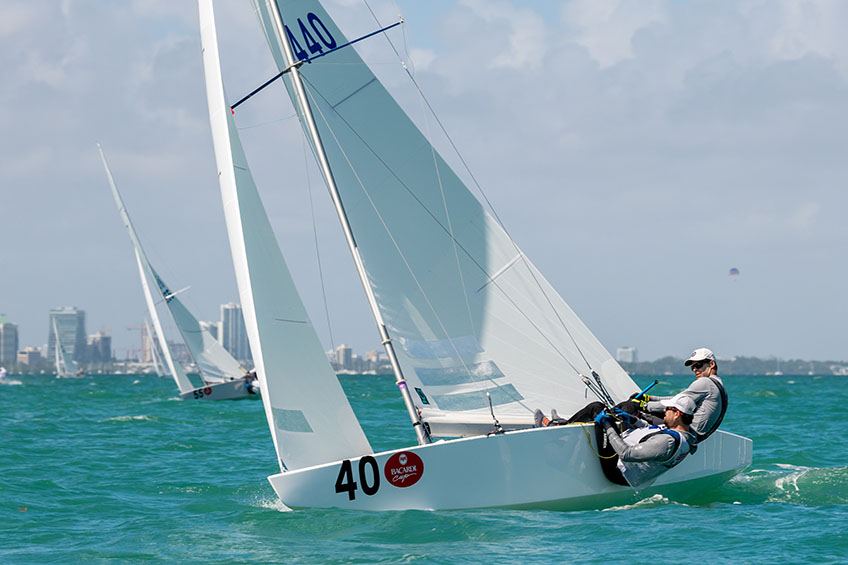We’ve rounded up the Quantum team to share some lessons they’ve learned at recent regattas. Read on for tips on how to make your next regatta an even bigger success.

Quantum San Diego’s George Szabo learned a lesson after sailing with new equipment at this year’s Bacardi Cup.
1. Measure Everything
Sailing a Star at this year’s Bacardi Cup Invitational, we learned again the importance of measurements. Measure everything! After setting up the boat on the first day, things were noticeably looser after sailing. For the next two days of racing, things were still stretching and not quite settling in. We carefully documented all our settings before, during, and after racing to help in our analysis, debrief, and strategy going forward. On day three, we were several turns tighter on the shrouds and at the same tuning numbers, but we were faster than the previous days. Honestly, we were slightly perplexed, but through consistent measurements and verifying our settings each day, we made progress and increased boat speed as the event carried on. Measure, measure, re-re-measure.
Here are a few tips from Quantum Detroit’s Wally Cross after coming off a fantastic week in Charleston, racing in the highly competitive J/70 fleet.
2. Race with Friends
Racing with friends is really fun, and time spent in the boat racing in more future events will pay off. So that just means more quality time with good friends − a win-win for sure.
3. Surround Yourself with Greatness
It’s important to practice with other good racers in your class. You’ll improve quickly when you’re pushing yourself and surrounding yourself with the top boats. Tuning-up on the water before racing should be a part of your daily routine at regattas. Practicing with top teams will also help you build relationships with them throughout the regatta. If you’re struggling in a certain condition, they might have some pointers they’re willing to share.
4. Practice Starts
Starting in a tight fleet has its challenges. We observed how the best teams with great boat handling were able to protect a hole. Setting up late worked when there was room to leeward of a boat, yet top teams knew how to maneuver their boat to be in a position of clear air even in a crowded starting line. Practice starting techniques often. Try drills where you keep the boat controlled at low speeds and accelerate off the starting line.
5. Understand the Racetrack
In Charleston, the tides can fluctuate almost seven feet, which creates massive current. Knowing which side of the course you want to be on, based on the current, is essential to executing your race strategy. The locals know where back eddies are and where to avoid adverse current as well as how to use the deepest, fastest moving water to your advantage.
6. Perfect Your Boat Handling
Perfecting wing on wing in the J/70 is a must, yet it isn’t easy. Practicing this maneuver to master the technique takes time and repetition. As I mentioned earlier, sail often and work on perfecting your skills.
7. Tuning
The Quantum Sails J/70 tuning guide was helpful for us, yet my biggest regret was not setting up this boat to the recommended rake. Our boat was older with a shorter headstay, and we sailed almost three-quarters of an inch less rake than recommended. It was clear to us that we needed the rake as the wind increased. In the next event, we will sail against the best early and stick to the tuning guide. Lesson learned.
David Flynn, one of Quantum Sails’ distance racing and offshore experts, shares two tips to consider as you prepare for your next high-seas adventure.
8. Don’t Let Preconceived Notions Rule
How many times have you heard that you always go down the western shore when doing a Down the Bay race on the Chesapeake? Or that you always go to the west of the rhumb line on the Newport Bermuda race? It’s not true! You have to be ready to sail the conditions you have. Use all the modern weather and routing options you can find to help you anticipate what you might encounter, and then develop a plan, but don’t forget the basics like heading toward the mark and sailing the long tack first. I can’t tell you how many Governor’s Cups and Solomons Island races have been won by the boat beating down the Bay that went straight on starboard almost fetching and then got lifted in the end spending little or no time on port. All those who tacked early (because you always go west) were far behind because they had wasted time on port tack.
9. The Rhumb Line is Irrelevant
The line you draw on the chart from start to finish is meaningless. You should care less if you are one or 10 miles off that imaginary line. All you care about is distance to the finish from where you are. Instead, you should imagine a series of concentric circles, 10 miles apart, emanating from the finish. The game is to get through these circles as fast as possible, regardless of how far left or right from the original rhumb line you are. The weather is going to change. Here’s a simple example: I can just fetch, and try to lay the mark. Or, cracked off 10 degrees, I cannot sail straight to the mark but I am two knots faster. Later the wind shifts to the left and I can fetch, but since I have been sailing two knots faster for the last 12 hours, I am now more than 20 miles closer to the mark. Voila!
For more resources and expertise, get in touch with your local loft.